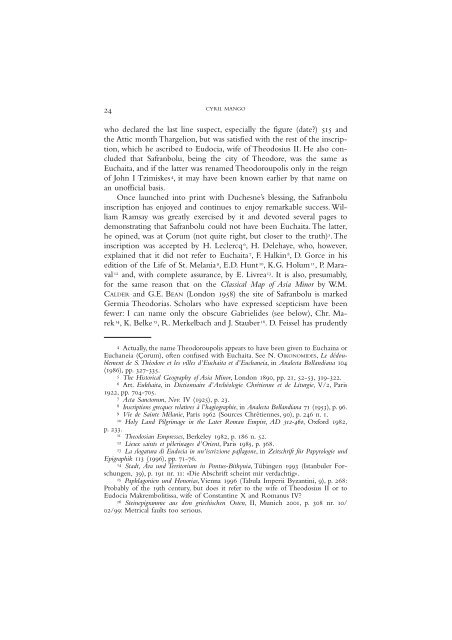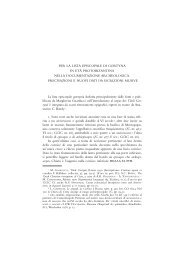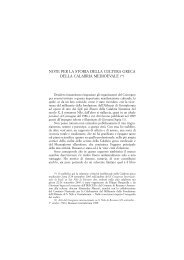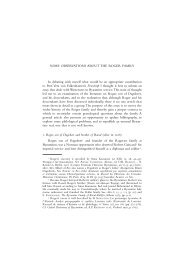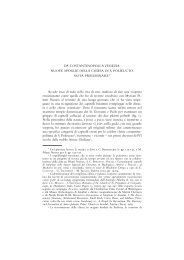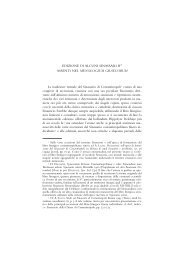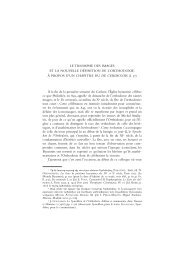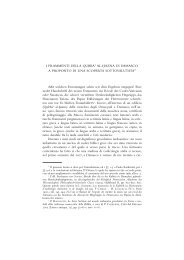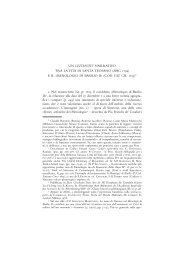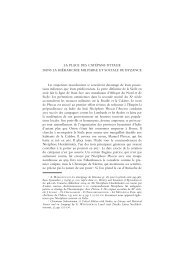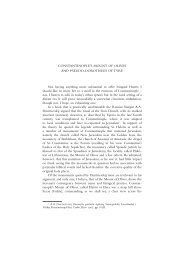Cyril Mango
Cyril Mango
Cyril Mango
Create successful ePaper yourself
Turn your PDF publications into a flip-book with our unique Google optimized e-Paper software.
24<br />
CYRIL MANGO<br />
who declared the last line suspect, especially the figure (date?) 515 and<br />
the Attic month Thargelion, but was satisfied with the rest of the inscription,<br />
which he ascribed to Eudocia, wife of Theodosius II. He also concluded<br />
that Safranbolu, being the city of Theodore, was the same as<br />
Euchaita, and if the latter was renamed Theodoroupolis only in the reign<br />
of John I Tzimiskes 4 , it may have been known earlier by that name on<br />
an unofficial basis.<br />
Once launched into print with Duchesne’s blessing, the Safranbolu<br />
inscription has enjoyed and continues to enjoy remarkable success. William<br />
Ramsay was greatly exercised by it and devoted several pages to<br />
demonstrating that Safranbolu could not have been Euchaita. The latter,<br />
he opined, was at Çorum (not quite right, but closer to the truth) 5 . The<br />
inscription was accepted by H. Leclercq 6 , H. Delehaye, who, however,<br />
explained that it did not refer to Euchaita 7 , F. Halkin 8 , D. Gorce in his<br />
edition of the Life of St. Melania 9 , E.D. Hunt 10 , K.G. Holum 11 , P. Maraval<br />
12 and, with complete assurance, by E. Livrea 13 . It is also, presumably,<br />
for the same reason that on the Classical Map of Asia Minor by W.M.<br />
CALDER and G.E. BEAN (London 1958) the site of Safranbolu is marked<br />
Germia Theodorias. Scholars who have expressed scepticism have been<br />
fewer: I can name only the obscure Gabrielides (see below), Chr. Marek<br />
14 , K. Belke 15 , R. Merkelbach and J. Stauber 16 . D. Feissel has prudently<br />
4 Actually, the name Theodoroupolis appears to have been given to Euchaina or<br />
Euchaneia (Çorum), often confused with Euchaita. See N. OIKONOMIDES, Le dédoublement<br />
de S.Théodore et les villes d’Euchaita et d’Euchaneia, in Analecta Bollandiana 104<br />
(1986), pp. 327-335.<br />
5 The Historical Geography of Asia Minor, London 1890, pp.21, 52-53, 319-322.<br />
6 Art. Eukhaita, in Dictionnaire d’Archéologie Chrétienne et de Liturgie, V/2, Paris<br />
1922, pp.704-705.<br />
7 Acta Sanctorum, Nov. IV (1925), p. 23.<br />
8 Inscriptions grecques relatives à l’hagiographie, in Analecta Bollandiana 71 (1953), p. 96.<br />
9 Vie de Sainte Mélanie, Paris 1962 (Sources Chrétiennes, 90), p. 246 n. 1.<br />
10 Holy Land Pilgrimage in the Later Roman Empire, AD 312-460, Oxford 1982,<br />
p. 233.<br />
11 Theodosian Empresses, Berkeley 1982, p.186 n. 52.<br />
12 Lieux saints et pèlerinages d’Orient, Paris 1985, p.368.<br />
13 La slogatura di Eudocia in un’iscrizione paflagone, in Zeitschrift für Papyrologie und<br />
Epigraphik 113 (1996), pp. 71-76.<br />
14 Stadt, Ära und Territorium in Pontus-Bithynia, Tübingen 1993 (Istanbuler Forschungen,<br />
39), p. 191 nr. 11: «Die Abschrift scheint mir verdachtig».<br />
15 Paphlagonien und Honorias,Vienna 1996 (Tabula Imperii Byzantini, 9), p. 268:<br />
Probably of the 19th century, but does it refer to the wife of Theodosius II or to<br />
Eudocia Makrembolitissa, wife of Constantine X and Romanus IV?<br />
16 Steinepigramme aus dem griechischen Osten, II, Munich 2001, p.308 nr. 10/<br />
02/99: Metrical faults too serious.


